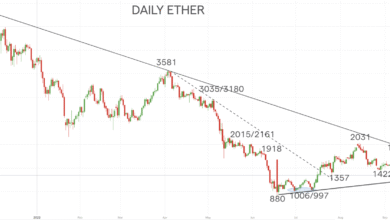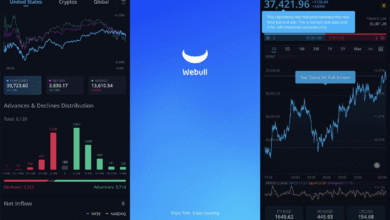Bitcoin Resilience Signals Maturity Amid Tariff Chaos
Bitcoin resilience has emerged as a beacon of stability amidst the chaos of global trade uncertainties and shifting policy landscapes. A recent analysis by QCP Capital highlights how Bitcoin’s steadfastness contrasts sharply with the weakness seen in technology equities, particularly following President Trump’s unexpected 50% tariff proposal on EU goods. This turmoil has sent shockwaves through the equities market, yet Bitcoin showcases a remarkable ability to rebound, underscored by record levels of institutional inflows. These developments indicate that many investors are increasingly viewing Bitcoin not just as a speculative asset, but as a potential safe haven in a turbulent economic environment. As global markets continue to grapple with uncertainties such as Trump tariffs and inflation pressures, Bitcoin’s resilience may redefine its standing in the broader crypto market analysis.
The robustness of cryptocurrency, particularly Bitcoin, plays a crucial role in today’s volatile economic climate. In light of recent geopolitical tensions and the pressures of governmental policies, such as President Trump’s tariff implementations, Bitcoin stands out as a symbol of strength. QCP Capital’s insights emphasize that institutional interests are gravitating towards Bitcoin, reflecting a desire for stability in the face of fluctuating equity markets and global trade challenges. As traditional markets exhibit fragility, Bitcoin’s capacity for recovery amidst adverse conditions showcases its evolution towards a fundamental asset class. This shift illustrates the broader recognition of digital currencies as viable investment vehicles, mitigating risks associated with economic uncertainty.
QCP Capital’s Insight on Crypto’s Evolving Role
QCP Capital’s recent report emphasizes the growing maturity of the cryptocurrency market, particularly in light of the geopolitical turbulence spurred by Trump’s proposed tariffs. As global trade uncertainty escalates, the report suggests that cryptocurrencies, and notably bitcoin, are becoming increasingly vital components of a diversified investment portfolio. This shift reflects a broader trend where institutional investors are recognizing the potential of digital assets to serve as protective vehicles in times of economic volatility.
The findings released by QCP highlight that bitcoin is no longer viewed merely as a speculative asset but is gaining recognition for its stability and resilience. The firm points out that sustained institutional inflows indicate a shift in investor sentiment towards crypto assets, marking a pivotal moment as these assets are increasingly integrated into mainstream investment strategies. This evolution demonstrates a growing acceptance of the crypto market as a serious contender in global finance.
Bitcoin Resilience Amid Global Trade Uncertainty
In the wake of President Trump’s tariff proposal, bitcoin’s performance stands out amid increased global trade uncertainty. While traditional markets faced immediate sell-offs, bitcoin’s resilience underscores its positioning as a safe haven asset. QCP Capital remarks on this phenomenon, noting that institutional capital is flowing into bitcoin, which is seen as a hedge against both economic instability and the unpredictable nature of global policy decisions.
The consistent demand for bitcoin, evidenced by record levels of institutional inflows, reflects a strategic shift among large investors. These players recognize bitcoin not just as a speculative asset, but as an essential component within a diversified portfolio, particularly during times of heightened economic ambiguity. This growing trend of capital allocation towards cryptocurrencies signals a transformative moment in how financial actors view and interact with digital assets.
Analyzing Institutional Inflows into Bitcoin
QCP Capital has highlighted that institutional inflows into bitcoin have reached unprecedented levels, with the Blackrock spot bitcoin ETF, IBIT, showcasing a record 30 consecutive days of net positive inflows. This trend is significant as it illustrates a sustained interest from larger institutional players, who are increasingly integrating bitcoin into their investment strategies. The inflows emphasize that institutions view bitcoin as a long-term asset rather than a mere short-term commodity.
This rise in institutional interest is particularly noteworthy against the backdrop of ongoing global trade tensions. As traditional equity markets exhibit volatility, institutions are pivoting towards crypto assets as a means of diversification and risk management. The robust inflow trends reveal a structural demand for bitcoin, which is increasingly seen as a legitimate asset class that can offer competitive returns in contrast to traditional equities.
Understanding the Impact of Trump’s Tariffs on the Crypto Market
Trump’s announcement of a 50% tariff on EU goods not only rattled traditional markets but also provided a unique lens through which to analyze crypto market behavior. According to QCP Capital, the resulting chaos in the equity markets has inadvertently highlighted bitcoin’s emerging role as a stabilizing asset during turbulent times. In this new era of policy uncertainty, bitcoin has shown the ability to withstand external shocks, reflecting its growing maturity as an asset.
The impact of these tariffs extends beyond immediate market reactions, as they signal a longer-term shift in how investors view risk and asset allocation. Cryptocurrencies, particularly bitcoin, are increasingly adopted as hedges against the unpredictability of global trade relations and economic policies. The analysis from QCP suggests that in a market characterized by volatility, cryptocurrencies may soon solidify their place as essential components in investment strategies aimed at navigating such uncertainties.
The Divergence of Crypto and Tech Equities
QCP Capital’s analysis points to an intriguing divergence between the performance of cryptocurrency markets and tech equities. While traditional tech investments have seen sustained outflows, digital assets, particularly bitcoin, are attracting increasing capital from institutional investors seeking stability amid policy fluctuations. This trend underscores the perception among investors that cryptocurrencies hold particular advantages during economic downturns when traditional equity markets exhibit heightened volatility.
This separation in asset performance reflects a deeper market sentiment where cryptocurrencies are valued not only for their growth potential but also for their role as a hedge in times of economic uncertainty. The ongoing capital rotation from tech stocks to cryptocurrencies signals a paradigm shift in investment behavior, illustrating how crypto is increasingly embraced as a viable and resilient alternative within the modern financial landscape.
Future Policy Shifts and Their Implications for Bitcoin
As we approach the newly set deadline for Trump’s tariffs, the crypto markets are bracing for potential policy shifts that could reshape trade dynamics, according to QCP Capital. Increasingly erratic policy moves underline the necessity for investors to adapt their strategies, and bitcoin is emerging as a pivotal asset in this landscape. The market’s anticipation of further shifts indicates a recognition of bitcoin’s role in providing stability amidst unpredictability.
The swift changes in market volatility, particularly highlighted by QCP, serves as a reminder of the fragile nature of recent bullish trends in equities. For investors, positioning in bitcoin might not only be a tactical move but a strategic necessity as global trade policies evolve. QCP emphasizes that as these dynamics unfold, bitcoin’s steady performance could offer a layer of protection against the uncertainties that come with shifting geopolitical landscapes.
Geopolitical Forces Shaping Crypto Investments
The interplay of geopolitical events, such as Trump’s tariffs, is increasingly shaping the investment landscape for cryptocurrencies. As global markets react to policy changes, QCP Capital notes that bitcoin stands resilient, attracting substantial institutional focus. The geopolitical landscape presents both challenges and opportunities for crypto assets, as traders look for vehicles that can weather economic upheaval while providing a hedge against inflation and uncertainty.
By recognizing how global trade tensions influence market behavior, investors can better understand the drivers behind crypto market movements. QCP argues that in these tumultuous times, bitcoin serves not only as an investment opportunity but also as a strategic asset for managing risk. The analysis suggests that as geopolitical uncertainties persist, the demand for cryptocurrencies will likely continue to rise, solidifying their position within traditional finance.
Navigating Inflation Pressures with Bitcoin
Inflation remains a critical concern in light of recent economic reports that could influence Federal Reserve policy decisions. QCP Capital emphasizes the emerging narrative of bitcoin as a hedge against inflation amidst rising costs driven by factors such as port congestion and tariff implications. As inflationary pressures mount, institutional investors are increasingly viewing bitcoin as a safeguard against eroding purchasing power—a shift that reinforces its standing within diversified portfolios.
This perspective shifts the dialogue surrounding bitcoin from mere speculative narrative to a more mature understanding of its role in macroeconomic stability. By integrating bitcoin into their investment frameworks, institutions are signaling a proactive approach to safeguarding their assets against inflation. QCP’s insights underline the potential for bitcoin to serve as a durable asset capable of preserving value even during times of economic turbulence.
Conclusion: The Maturing Role of Bitcoin in Global Markets
In conclusion, QCP Capital’s analysis paints a picture of a maturing cryptocurrency market, particularly bitcoin, which has established its foothold as a hedge amidst global trade uncertainties and economic volatility. As institutional inflows continue to rise, the perception of bitcoin is evolving from being a speculative asset to a critical component in intelligent, forward-thinking investment strategies.
With geopolitics and policy decisions shaping the financial landscape, bitcoin’s resilience is increasingly viewed as indicative of its strength and potential. As investors seek stability in the face of uncertainty, the role of cryptocurrencies in global portfolios is likely to expand, cementing bitcoin’s place as a significant player in the future of finance.
Frequently Asked Questions
How does Bitcoin resilience compare to traditional equities in times of uncertainty?
Bitcoin resilience has been highlighted as a key factor in its performance during periods of global trade uncertainty, such as during the recent Trump tariffs announcement. While traditional equities, like the S&P 500, experienced volatility and sell-offs, Bitcoin showcased its maturity as a stable asset, attracting strong institutional inflows. This growing divergence indicates that investors are increasingly viewing Bitcoin not just as a speculative play, but as a viable hedge against uncertainty.
What role do institutional inflows play in demonstrating Bitcoin resilience?
Institutional inflows are crucial in showcasing Bitcoin resilience, especially during geopolitical turmoil. Recent analysis from QCP Capital indicates that Bitcoin has seen record inflows, particularly through instruments like Blackrock’s spot Bitcoin ETF, which experienced 30 consecutive days of net inflows. This trend underscores the deepening institutional interest and highlights Bitcoin’s evolving reputation as a resilient asset amid fluctuating market conditions.
What can the recent market reactions to Trump tariffs tell us about Bitcoin resilience?
The recent market reactions to Trump tariffs revealed Bitcoin’s ability to maintain stability in the face of macroeconomic chaos. Following the tariff announcement, traditional markets faltered while Bitcoin’s resilience enabled it to rebound quickly. According to QCP Capital, such resilience suggests that Bitcoin is increasingly viewed as a ‘grown-up’ asset in the investment landscape, capable of withstanding shocks that negatively impact traditional equities.
How does Bitcoin’s resilience affect its role in global portfolios amid trade uncertainties?
Bitcoin’s resilience significantly enhances its role in global portfolios, especially during periods of heightened trade uncertainty. As outlined by QCP Capital, the cryptocurrency is increasingly being viewed as both a hedge and a standalone investment opportunity, attracting continued capital inflows. This shift indicates that investors are incorporating Bitcoin into their strategies to mitigate risks associated with erratic policymaking and traditional asset volatility.
What are some factors influencing Bitcoin resilience during economic downturns?
Factors influencing Bitcoin resilience during economic downturns include institutional participation, market maturity, and its perception as a safe-haven asset. QCP Capital notes that despite the turbulence caused by global trade uncertainty, Bitcoin’s ability to draw significant institutional interest signals its status as a reliable option in investors’ portfolios. Additionally, macroeconomic conditions, such as inflation and regulatory shifts, further enhance or challenge Bitcoin’s resilience.
Why is Bitcoin’s resilience significant in the current economic climate?
In the current economic climate marked by uncertainty, Bitcoin’s resilience is significant as it reflects its maturation as an asset class. According to QCP Capital’s analysis, as traditional markets react negatively to geopolitical events, Bitcoin’s steady performance amidst evolving policy landscapes suggests its potential as a robust investment. This reliability attracts investor confidence, reinforcing its position as a growing component of diversified portfolios.
| Key Point | Details |
|---|---|
| Trump’s Tariff Proposal | A surprise 50% tariff on EU goods by Trump has reignited global trade uncertainty, affecting market sentiment. |
| Bitcoin’s Resilience | Despite market turbulence, Bitcoin showed strong rebound signals, attributed to substantial institutional inflows. |
| Institutional Flows | Blackrock’s Bitcoin ETF recorded record net inflows, indicating that institutional participation in crypto is growing. |
| Divergence from Tech Equities | While tech equities have experienced outflows, cryptocurrencies continue to attract steady investment. |
| Market Volatility | The recent tariff announcement reversed a period of declining volatility, highlighting the fragility of market gains. |
| Economic Pressures | Inflation and port congestion threaten to increase shipping costs, creating indirect inflationary pressures. |
| Investor Sentiment | Investors are viewing crypto as a hedge against policy uncertainty and a viable standalone investment opportunity. |
Summary
Bitcoin resilience has emerged as a critical factor in the current economic landscape, particularly in light of recent geopolitical tensions and shifting market dynamics. The ability of Bitcoin to maintain strength amidst turmoil, highlighted by substantial institutional investments, indicates its increasing role as a secure asset in volatile environments. As traditional equities face significant risks from erratic policymaking, Bitcoin is being recognized not only as a hedge against uncertainty but also as a mature investment avenue in global portfolios.




